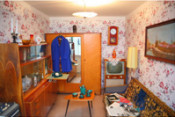
Museums of Russia: The Museum of Contemporary History of Russia opens the updated branch “Presnya”
The Museum of Contemporary History of Russia opens to the public the updated branch "Presnya", which renovated rooms dedicated to armed uprising of 1905 and the history of Russian everyday life the beginning of the XX century.
In the updated section "Presnya" is opened a new exhibition dedicated to the history of the everyday life of people in different periods of the XX century.
The exposition, consisting of 3 sections, features more than 1,000 unique exhibits from the stock collection of the Museum of Contemporary History of Russia.
In the first section is exhibited a unique memorial complex interior: a study of Foster Chairman of the Supreme Soviet of the USSR Mikhail Ivanovich Kalinin, typological reconstruction of the USSR Cabinet of senior governing party official of 1945-1950s and working place in the Mission Control Center of spacecraft, unmanned stations, manned spacecraft, which was created on October 3, 1960 in the Moscow region.
The second section of the exhibition reflects the main changes in the everyday lives of people and the transformation of the material environment under the influence of global historical events as the Great Russian Revolution of 1917, Soviet modernization and the Soviet people's victory in the Great Patriotic War of 1941-1945. It is open with interiors that characterize everyday life for the representatives of new Russia of the early XX century social groups - entrepreneurs and hired hands.
The Soviet period is represented by typological reconstructions of communal apartment of 1920-1930s, Pioneer House, the upper chamber of the rural house and the installation telling of the geological exploration of new mineral deposits in the harsh war years in western Siberia.
In the third section of the exposition is presented the typological reconstruction of small apartments in five-storey building - "Khrushchevka". This studio apartment and apartment in which visitors can look at a meeting of representatives of youth subcultures - mods. The feeling of the era in the interior complements the paintings hanging on the walls of the non-conformist artist.
The characteristic features of everyday life of the Soviet people, as well as new developments of Russian reality reveal typological reconstruction of apartments with improved layout in the "sleeping" area, terrace of the garden house on 6 acres, a small wholesale market installation of the mid-1990s and interior fragment of a country house in the cottage.

